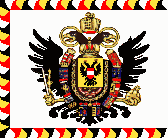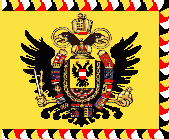
Austrian Artillery
[Officer, Gunner and Train-Driver]


{Österreichische Artillerie während
der Napoleonischen Kriege}
1. Austrian Artillery.
2. Organization.
3. Eqipment.
4. Austrian Engineers.


Austrian Artillery.
The experiments had enabled Liechtenstein to lighten both the barrels and the carriages without any sacrifice of robustness or performance, and thus reduce the overall weight of the pieces by up to half. The rate of fire of the mortars and field pieces increased. All the work of elevating and depressing the massive barrels was now done by a simple screw device. Liechtenstein did away with the slow, wasteful and dangerous bussiness of loading the loose powder down the muzzles from open-topped ladles, which were replenished from open powder kegs.
The charges were now contained in linen cartridges, which were inserted into the muzzle intact, rammed down solidly against the bottom of the barrel, and the missile in turn seated firmly on top.
The pre-Napoleonic Austrian artillery was held up as an example to the world. It enjoyed a high reputation for the quality of gun powder and ammunition. The artillerymen, recruited mostly from the German provinces, has always stood high; not so much by early and judicious adoption of improvements, as by the practical efficiency of the men. In 1805 Prince Czartoryski noted that before the battle of Austerlitz "Anxiety was impressed on the faces of the Austrian General, the officers and even the soldiers. The artillery officers alone did not give way to the general depression, and expressed absolute confidence in the effect of their guns." (Czartoryski - "Memoirs of Prince Czartoryski ..." II, p 107) The gunners were volunteers and not recruits as it was the case in majority of European armies. The rank and file were able to read and write in German, the NCOs and officers were professionals. The enlistments were 14 years for artillery and engineers as comparing to only 6 years for infantry. The famous French Gribeauval system was based on Austria’s Lichtenstein system. In 1811 Austria also began the establishment of rocket troops based upon the British invention. Several French commanders, incl. Massena, admired the Austrian artillery and its professionalism. It was indeed excellent troop. Some examples: in 1813 at Leipzig general Bubna detached 2 horse batteries (12 guns) against 21 Saxon and French guns near Paunsdorf. After 30 minutes of cannonade, despite being outnumbered almost 2 to 1 the Austrian gunners lost only 6 guns while dismounted 7 enemy guns. In 1809 at Essling Austrian artillery rained death and destruction on Lannes assault columns. Taking heavy casualties - the French were forced to retire. Napoleon's gamble had failed.
The comparison of the French and Austrian artillery is quite interesting. The Austrian artillery had powder and ammunition of higher quality than French. The gunners of Austrian horse artillery sat on caission while the French were mounted on horses. It made the Austrian batteries slower in movement across fields and roads, but they were quicker in deploying and unlimbering the guns. The Austrians also needed less horses, were cheaper, required less space and therefore were a smaller target for enemy's guns. But in general the French gunners were more dashing and imaginative and their guns had longer range and bigger calibres than Austrians'. For example in 1798 the captured 6pdr Austrian guns were equal to French 5pdrs (the Austrian pound was smaller than the French).
|
|

Equipment.
The woodwork of Austrian gun was painted in ochre and metal parts in black. The carriages and ammunition wagons were painted in yellow. The oil paint increased the resistance of the wood
against "the damp and bad weather of all kinds." All items were branded with the same number as the piece "so that everybody knows whom they belong to, and can be held responsible for looking after them."
|

Austrian Engineers.
"The fundamental business of military engineers in the 18th century was to build and attack fortresses. Nobody was better at this work than the French, who under the inspired direction of Sebastien Le Prestre de Vauban (1633-1707) ... had fortified the frontiers of France with multiple lines of strongholds, developed techniques of scientific precision to capture the fortresses of the enemy, and established a corps of engineers on a professional footing, complete with an exhaustive training ...
According to John Stallaert the Engineer-Corps was composed exclusively of officers; they controlled two battalions of rank-and-file. The Sappers were responsible for field fortification. The Miners were trained in siege techniques. In wartime they were supplemented by Pioneers, less skilled engineers generally disbanded at the close of hostilities.
In 1805-1809 Austria had: At Wagram (1809) Austrian engineers had launched a succession of floating mills and boats laden with rock into the current of Danube River to destroy the French bridge. They also set fire to some of the boats and had strengthened the positions near Enzersdorf with fieldworks. Picture of Austrian pioneer in 1809 (ext.link) |

Sources and Links.
Dolleczek - "Geschichte der österreichischen Artillerie" 1887
Bowden, Tarbox - "Armies on the Danube 1809" 1981
Duffy - "The Army of Maria Theresa" 1977
Maude - "The Ulm Campaign 1805"
Arnold - "Napoleon Conquers Austria"
Regele - "Feldmarshall Radetzky. Leben, Leistung, Erbe." 1957
Rothenberg - "Napoleon's Great Adversaries: The Archduke Charles."
Major Semek - "Die Artillerie im Jahre 1809" published in 1904
John Stallaert's website "The Evolution of Napoleonic Uniforms"
flags from warflag.com